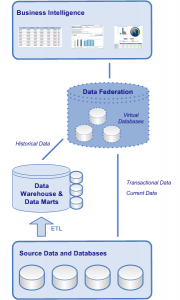Data Federation Technology – Pros and Cons

- Data federation is a category of data integration technology that provides the ability to query and aggregate data from disparate sources in a virtual database so it can be used by business intelligence, reporting, or analysis applications in real-time. The virtual database created by data federation technology doesn’t contain the data itself. Instead, it contains information or metadata about the actual data and its location. The actual data is physically left in place within its source data repository.
Data federation is used to create virtualized and integrated views of data and allows for execution of distributed queries against multiple data sources (relational databases, enterprise applications, data warehouses, documents, XML) at the same time. Data federation allows for accesses to data without physical movement of data and provides a layer of abstraction above the physical implementation of data.
- Data federation is synonymous with other technologies and commonly referred to as …
- • Data Virtualization
- • Enterprise Information Integration (EII)
Pros of Data Federation
- • Access current and transactional data stored in multiple sources
- • Does not require movement of data (No ETL)
- • Only requested data returned
- • Real-time data access
- • Quicker development time – supports incremental development
- • Reduces data storage and data transfer
Cons of Data Federation
- • Still queries against original data sources
- • Only contains as much data as source system contains
- • If data is archived off source, data is no longer available in federation tool
- • Query performance is not as good as a data warehouse
- • High system performance transferred to an application server from a database server

